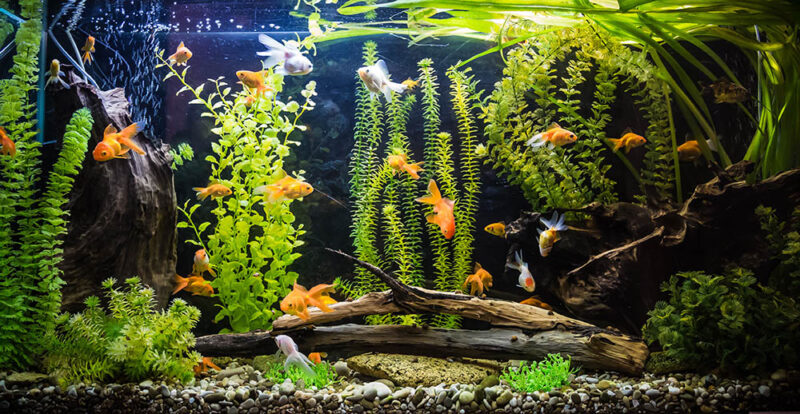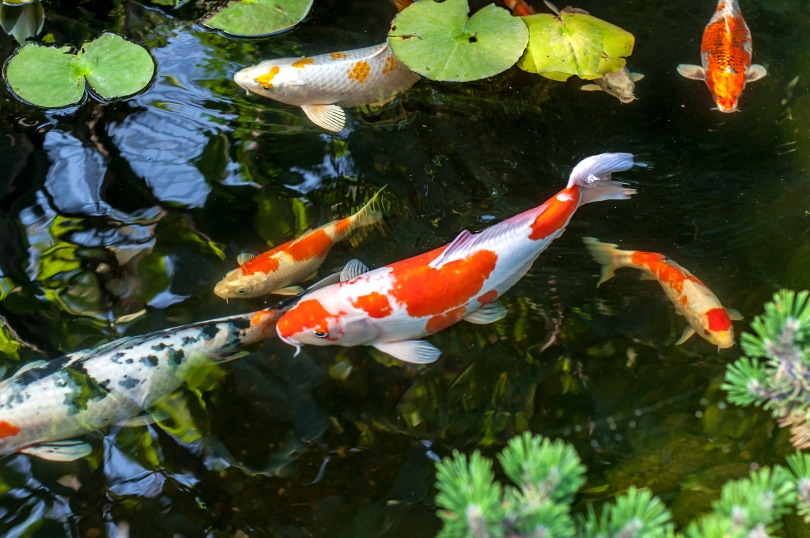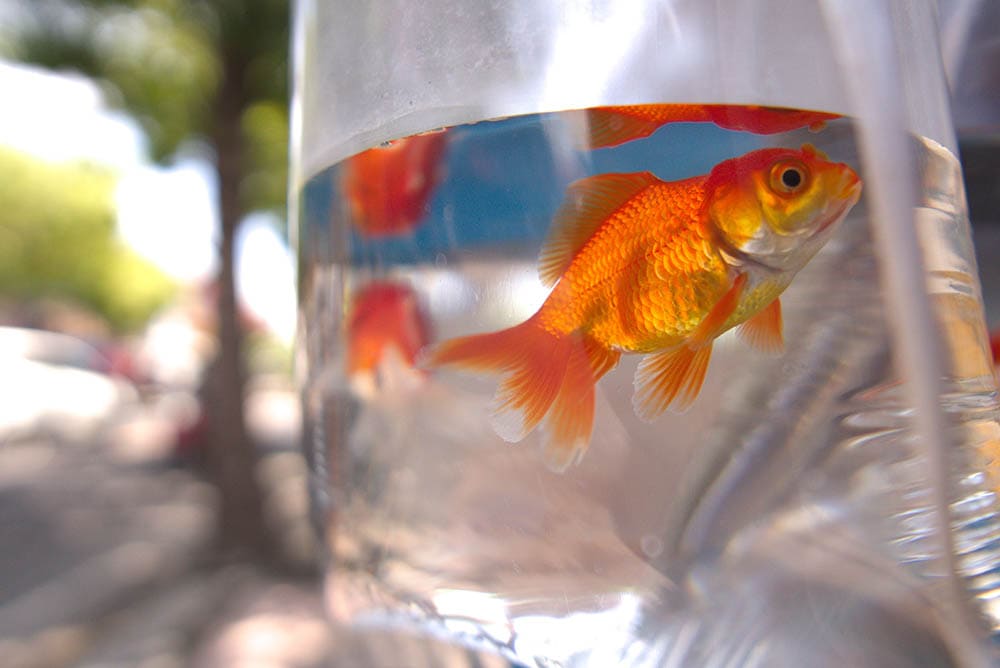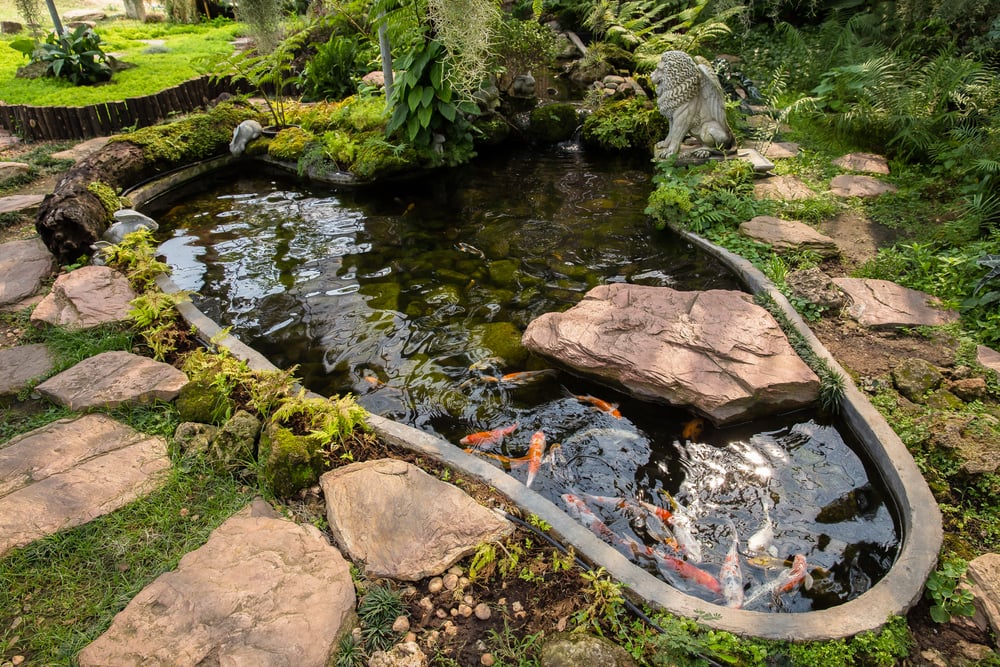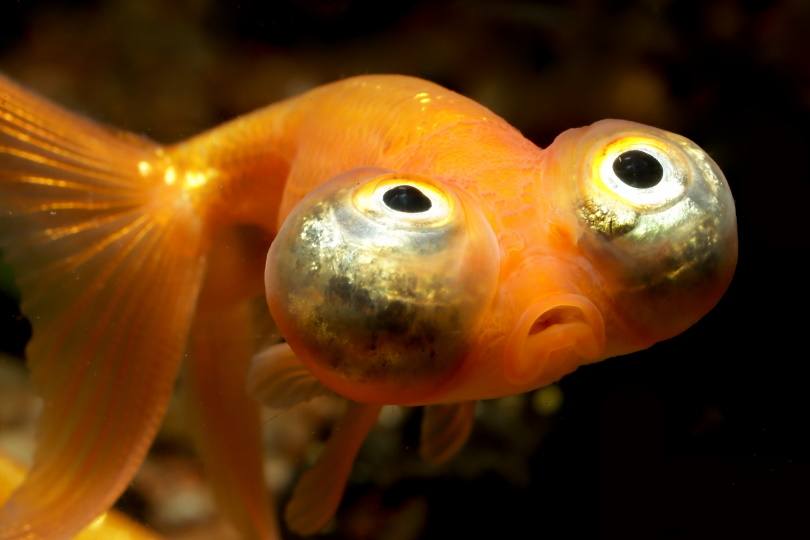
Click to Skip Ahead
The celestial eye goldfish is an unusual goldfish breed named for its skyward gaze. They’re cute and unique fish that are more difficult to care for than many other goldfish breeds, making them unsuitable for every home and goldfish tank. Special considerations must be applied to these delicate fish to allow them to live a long and healthy life.
Quick Facts about Celestial Eye Goldfish
| Species Name: | Carassius auratus |
| Family: | Cyprinidae |
| Care Level: | Moderate |
| Temperature: | 65–72°F |
| Temperament: | Peaceful |
| Color Form: | Gold, white, red, bicolor |
| Lifespan: | 10–15 years |
| Size: | 5–6 inches |
| Diet: | Omnivorous |
| Minimum Tank Size: | 10 gallons |
| Tank Setup: | Freshwater |
| Compatibility: | Other fancy goldfish; peaceful tank mates not prone to fin nipping |
Celestial Eye Goldfish Overview
Celestial eye goldfish are odd goldfish, thanks to their appearance. They originated in Asia from the wild carp ancestors of all goldfish. This breed is believed to have originated in Japan, and they entered the United States from Japan in the earliest part of the 20th century. It’s believed that the breed originated sometime around the end of the 1800s to the beginning of the 1900s, shortly before they made their first appearance in the US.
They are interesting goldfish that can add a striking look to your tank. However, their delicate eyes and long fins mean they are not suitable for tanks with rough objects and nipping tank mates. With proper care and a suitable tank environment, these goldfish can live for 10–15 years, so they are not as short-lived as some fancy goldfish breeds can be.

How Much Do Celestial Eye Goldfish Cost?
Like many fancy goldfish, the celestial eye will cost you more than the average feeder goldfish. You may luck into finding one for as little as $10, but you’re more likely to spend $15–30 on a single fish.
On top of this, you will also likely have to pay shipping fees since these goldfish may be difficult to find in an aquarium shop. Most online retailers ship live fish overnight or 2-day shipping, so you should expect to spend $20–50 or more on shipping fees alone.
Typical Behavior & Temperament
The celestial eye goldfish is a peaceful goldfish that shouldn’t cause any trouble in your tank. They spend most of the day scavenging for food in the bottom of the tank, but they may be spotted uprooting or eating plants.
Some celestial eye goldfish may interact with people when they notice them, especially the person or people who feed them. They may show excitement by swimming back and forth or approaching the front of the tank in anticipation of food.
Appearance & Varieties
The appearance of the celestial eye goldfish is distinct due to its telescope eyes that face upwards. They are similar in appearance and shape to the bubble eye goldfish but with the major difference of the orientation of the eyes.
Their body is an elongated egg shape, and they lack a dorsal fin. They have a fan-shaped tail that can vary from half to the full length of the body itself. They are generally only found in gold, white, or red but may also be bicolor orange and white or red and white.
How to Take Care of Celestial Eye Goldfish
Habitat, Tank Conditions & Setup
Tank Size
Goldfish tend to be high waste producers, so many people believe they need a large tank. Celestial eye goldfish stay small enough to happily live in a 10–20 gallon tank with proper filtration. If adequate filtration or a commitment to water changes multiple per month is difficult for you, then it’s best to invest in a 20–40 gallon tank or larger for a celestial eye goldfish.
Housing a goldfish isn't as simple as buying a bowl. If you're a new or experienced goldfish keeper who wants to get the setup right for your goldfish family, check out the best-selling book, The Truth About Goldfish, on Amazon.
It covers all you need to know about the ideal tank setup, tank size, substrate, ornaments, plants, and so much more!
Water Quality & Conditions
Goldfish require high water quality with no ammonia or nitrites. Nitrates are a normal part of the nitrogen cycle, but most people aim to keep their nitrate levels below 20–40ppm. The pH is best kept around neutral, with these fish thriving in a range from 6.0–8.0. They prefer water temperatures between 65–72°F but can do well in water as cool as 60°F and as warm as 75°F.
Substrate
There are a lot of schools of thought regarding the best substrate for goldfish. For celestial eye goldfish, you should avoid any substrate with sharp edges that may cause injuries to the eyes, like rocks, as well as substrate that is small enough to be consumed but large enough to be lodged in the mouth, like gravel.
Some people prefer bare bottom tanks for goldfish for ease of cleanup and safety for the fish. Sand and other fine, soft substrates are a good option for goldfish and do allow you to plant plants in the tank. Large, smooth rocks, like river rocks, are also a good option, although they can be difficult to clean around.
Plants
Goldfish are prone to eating plants in their tank, and celestial eye goldfish are no different. Plants that can be attached to surfaces, like Java ferns, are a great option. Other suitable plants that aren’t likely to be eaten include water sprite and hornwort, both of which can be planted in substrate or allowed to float.
Lighting
Celestial eye goldfish do not have specific lighting needs outside of normal day/night lighting. This can be achieved with a tank light or natural lighting in the room. However, they can be sensitive to bright lighting since their eyes face upwards. To protect their sensitive eyes, you should try to keep your direct tank from running at a high level.
Filtration
The filtration needs of your tank will be dependent on the size of the tank, the number of fish, and the regularity with which you perform water changes. You will not over filter your tank, but you can under filter your tank. When in doubt, go for a filter that is rated for a tank larger than the tank you have.
Sponge filters are a great addition to a goldfish tank, but they are not suitable as the only source of filtration. External, canister and internal filters are all good options.
Are Celestial Eye Goldfish Good Tank Mates?
Due to their peaceful nature, celestial eye goldfish can be great tank mates in the right tank. However, it’s important to pair them with other peaceful fish that will not nip at their fins or eyes. They tend to be slow swimmers, though, so their ideal tank mates are also slow-swimming fish that will not outcompete them for food.
Make sure to quarantine new goldfish before adding to your tank. The general recommendation is to quarantine your new fish for 4–8 weeks before adding them to your tank population to prevent the spread of disease. Once introduced to the general population in your tank, keep a close eye on things to ensure no bullying is occurring. Celestial eye goldfish are unlikely to be bullies, but they can easily be injured by a bully.
What to Feed Your Celestial Eye Goldfish
Celestial eye goldfish are omnivores that should be fed a high-quality diet. It’s recommended to feed them pellets, as they tend to be higher quality than flake foods, although this is not always the case. Fancy goldfish food is likely to meet the nutritional needs of your Celestial eye goldfish.
A varied diet is a good way to ensure your fish’s nutritional needs are met and provide enrichment to their environment. Many fruits and veggies are safe for goldfish, like lettuce, spinach, green beans, bananas, and squashes. You can also offer frozen and gel foods to provide more variety.
Keeping Your Celestial Eye Goldfish Healthy
The best ways to keep your celestial eye goldfish healthy are to provide good water quality and a safe environment. These fish are prone to eye injuries due to the exposed nature of their eyes, and they can easily lose an eye to an injury caused by tank décor or a tank mate. Ensure that your celestial eye is not being bullied by tank mates, and make sure to remove any pointed objects in the tank. Even objects with a dull point can injure or remove an eye.
Maintain high water quality with adequate filtration and perform routine water changes to help keep your celestial eye goldfish healthy. Test your water regularly, even after the tank is fully cycled, to ensure that your tank’s cycle is properly maintained and managing the waste in the tank.
Breeding
Breeding celestial eye goldfish is not any more difficult than breeding any other type of goldfish. By keeping a male and female together, you are likely to have the fish attempt to spawn at some point. To stimulate spawning, you can slowly increase the tank’s water temperature by a few degrees. This can simulate the natural temperature change that would lead to spawning in the wild when the water begins to warm in the spring.
Once the fish spawn, you will see the eggs in the tank. A spawning mop or plants can be used to make the eggs easier to find and retrieve. By moving the eggs to a separate tank or a breeder box, you will keep them safe from being consumed by the parents or their tank mates.
Are Celestial Eye Goldfish Suitable For Your Aquarium?
The celestial eye goldfish is a fascinating goldfish, but it’s not suitable for all aquariums. They are easily injured by rough tank mates and pointed objects, and they may even lose an eye in the wrong environment. They can live long, full lives with the right care, though.
They may cost more than the average goldfish, but they are far from the most expensive breed. However, a celestial eye goldfish is a commitment of time and money to provide a proper environment to ensure your fish is happy and healthy for as long as possible.
Conclusion
We hope this guide has given you some insight on the celestial eye goldfish. These are incredible fish to own, and can make a wonderful addition to a home aquarium. As with any pet, just ensure that you have the right environment and time to tend to the celestial eye goldfish.
Featured Image Credit: Dan Olsen, Shutterstock



